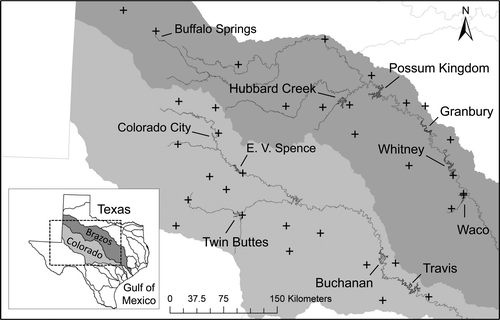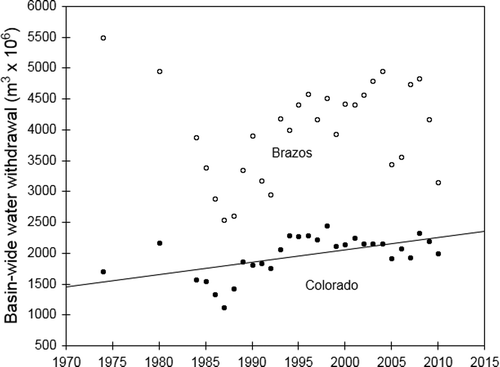Figures & data

Table 1 Water-quality and storage variables analyzed in reservoirs of the Brazos River basin for monotonic trends in their monthly values using Seasonal Kendall Tau test. Shown for each variable are the specific period of record (POR) for each analysis, tau, Sen slope (change per year), and minimum, median, and maximum values. Trends found to be significant after q-value correction (q < 0.05) are highlighted in bold, italic type. NA: either data were not available or available data did not meet minimum density criteria (see text); NC: Sen slope not calculated.
Table NaN Water-quality and storage variables analyzed in reservoirs of the Brazos River basin for monotonic trends in their monthly values using Seasonal Kendall Tau test. Shown for each variable are the specific period of record (POR) for each analysis, tau, Sen slope (change per year), and minimum, median, and maximum values. Trends found to be significant after q-value correction (q < 0.05) are highlighted in bold, italic type. NA: either data were not available or available data did not meet minimum density criteria (see text); NC: Sen slope not calculated. (Continued)
Table 2 Water quality and storage variables analyzed in reservoirs of the Colorado River basin for monotonic trends in their monthly values using Seasonal Kendall Tau test. Shown for each variable are the specific period of record (POR) for each analysis, tau, Sen slope (change per year), and minimum, median, and maximum values. Trends found to be significant after q-value correction (q < 0.05) are highlighted in bold, italic type. NA: either data were not available or available data did not meet minimum density criteria (see text); NC: Sen slope not calculated.
Table NaN Water quality and storage variables analyzed in reservoirs of the Colorado River basin for monotonic trends in their monthly values using Seasonal Kendall Tau test. Shown for each variable are the specific period of record (POR) for each analysis, tau, Sen slope (change per year), and minimum, median, and maximum values. Trends found to be significant after q-value correction (q < 0.05) are highlighted in bold, italic type. NA: either data were not available or available data did not meet minimum density criteria (see text); NC: Sen slope not calculated. (Continued)

Table 3 Results of quantile regression for detection of trends in annual reservoir inflow in the Brazos and Colorado river basins. Flow rate data were obtained from USGS gages on major streams upstream of reservoirs for the period of record (POR), which varied by gage. Distributions of daily average flow rates were constructed for each year of the POR, and annual changes (10−6 m3/s per year) in the 10th, 50th, and 90th quantiles were estimated (Estimated annual change). The 10th, 50th, and 90th quantiles (10−6 m3/s) were also estimated for the entire POR (Estimated for POR), and the estimated annual changes were also expressed as a percentage of this value (Percent annual change). Trends found to be significant after q-value correction (q < 0.05) are highlighted in bold type.
Table 4 Results of quantile regression for detection of trends in annual precipitation in the Brazos and Colorado river basins. Monthly precipitation totals were calculated from daily precipitation data obtained for the period of record (POR, 1965–2009) from the National Climatic Data Center for selected weather stations. Monthly totals were grouped by year, and annual changes (monthly sum in mm/yr) in the 10th, 50th, and 90th quantiles were estimated (Estimated annual change). The 10th, 50th, and 90th quantiles (monthly sum in mm) were also estimated for the entire period of record (Estimated for POR), and the estimated annual changes were also expressed as a percentage of this value (Percent annual change). Trends found to be significant after q-value correction (q < 0.05) are highlighted in bold type.
Table 5 Principal component analysis of monthly water quality data. Loading factors are shown for each variable in the first three principle components (PC) retained by the analysis. Variables with loadings ≥ |0.4| are highlighted in bold type. Eigenvalues, and proportional and cumulative variance are shown for each PC.


